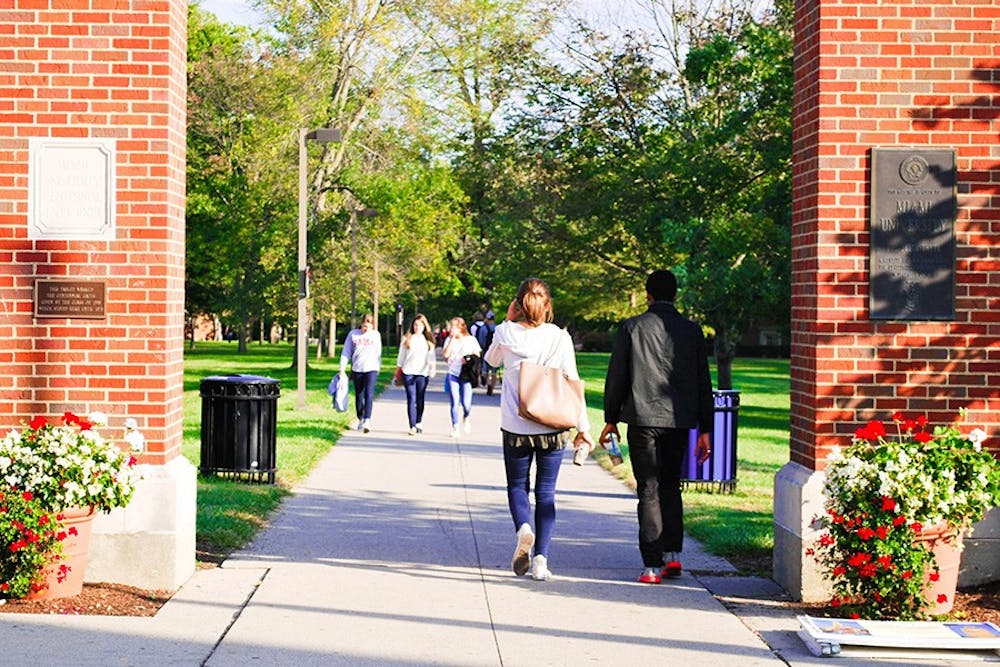WALK THE (SLANTED) LINE Passing through the Phi Delt gates, Miami students begin the scenic trek through campus.
Photo by Frankie Roskam
Mariah Schlossman, For The Miami Student
Miami has become more selective in its admissions process over the last few years, as it continues to draw in tens of thousands of high-caliber students while retaining its average class size.
As the ACT average has steadily increased and the acceptance rate has dropped, student interest in Miami University has steadily climbed.
Interim Director of Admission and Enrollment Communication Susan Schaurer said a clear distinction needs to be made between the words applied, admitted, accepted, confirmed and enrolled.
Schaurer said "applied" refers to the number of applications the university receives, "accepted" and "admitted" refer to the students that the university has offered admission to, and "confirmed" and "enrolled" describe the students who ultimately enter the institution.
According to the Enrollment Management Update presented at the Board of Trustees meeting Thursday, Sept. 18, Miami has seen a 12.3 percent increase in applied students and a 10.8 percent increase of students admitted, but a 0 percent increase of those confirmed from the 2013 data versus the 2014.
Although in the last five years, there has been a 50 percent increase in applications, the confirmed amount of students remains at 0 percent because of Miami's dedication to admitting an incoming class of about 3,600 students.
"The consistent incoming size of 3,600 is something that, after research and logistics, the leadership at Miami has decided is the right number for the natural selectivity of the university and to stay true to the critical Miami experience," Schaurer said.
With the average 3,600 class maximum, there is an increased selectivity in accepted students. According to the 2014 enrollment data and data from 2009, the average ACT increased from 26 to 27.7 and the acceptance rate is now 66.7 percent when in 2009 it was 80.4 percent.
Miami can accredit a large portion of the significant increase in applications to the strides they have made in the recruiting process. The university places regional recruiters strategically across the country in various locations.
There are two main factors that go into placing these recruiters. First, the university looks to the places where there are already a lot of enrolled students at Miami, such as Cincinnati, Columbus and Chicago areas. It is important to do this to maintain and develop the relationships that Miami has or will have with certain regions and high schools.
The second factor involves working with Wiche, a site that gives accurate projections on population increase and decrease, to find the places where there will be an increase of high school graduates in the coming years.
However, a more complicated issue that arises when discussing admissions is the amount of diversity present in the class sizes at Miami.
According to Ron Scott, Associate Vice President for Institutional Diversity, even with the gradual increase of applications and overall interest in Miami each year, additional steps can and should be taken in order to get increased diversity in the future.
"It's all about perception," Scott said. "The nearby universities such as the University of Cincinnati and The Ohio State University are perceived as having significantly more diversity than us when, in reality, they don't have that much more."
According to FindtheBest.com, a website dedicated to comparing schools' statistics side-by-side, 10 percent of Miami's incoming class is considered diverse, compared to Ohio State's 15 percent and the University of Cincinnati's 13 percent.
Scott also mentioned the competition that Miami faces with these schools that have an easier way of promoting themselves. In order to reach the maximum potential of diversity and the best students possible, Miami needs to change their rhetoric and the way potential students perceive the university.
"In regards to the future, we are going to continue to recruit and enroll the brightest, best, and most diverse class across the country," said Susan Schaurer.

